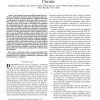Free Online Productivity Tools
i2Speak
i2Symbol
i2OCR
iTex2Img
iWeb2Print
iWeb2Shot
i2Type
iPdf2Split
iPdf2Merge
i2Bopomofo
i2Arabic
i2Style
i2Image
i2PDF
iLatex2Rtf
Sci2ools
TEC
2002
2002
Graph-based evolutionary design of arithmetic circuits
Abstract--In this paper, we present an efficient graph-based evolutionary optimization technique called evolutionary graph generation (EGG) and the proposed approach is applied to the design of combinational and sequential arithmetic circuits based on parallel counter-tree architecture. The fundamental idea of EGG is to employ general circuit graphs as individuals and manipulate the circuit graphs directly using new evolutionary graph operations without encoding the graphs into other indirect representations, such as bit strings used in genetic algorithm (GA) proposed by Holland and trees used in genetic programming (GP) proposed by Koza et al. In this paper, the EGG system is applied to the design of constant-coefficient multipliers and the design of bit-serial data-parallel adders. The results demonstrate the potential capability of EGG to solve the practical design problems for arithmetic circuits with limited knowledge of computer arithmetic algorithms. For example, in the design o...
| Added | 23 Dec 2010 |
| Updated | 23 Dec 2010 |
| Type | Journal |
| Year | 2002 |
| Where | TEC |
| Authors | Dingjun Chen, Takafumi Aoki, Naofumi Homma, Toshiki Terasaki, Tatsuo Higuchi |
Comments (0)

